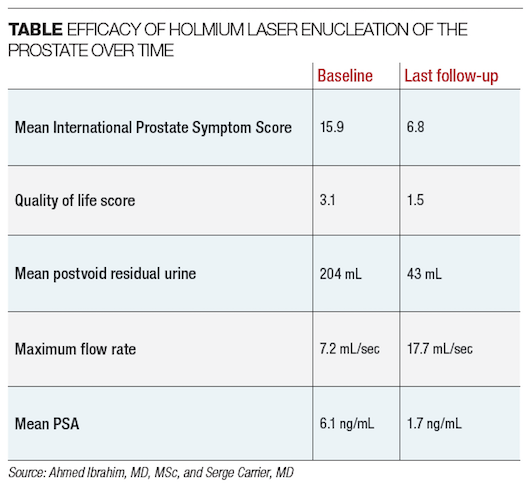Article
Data from 18-year study support HoLEP’s efficacy
Author(s):
Findings from an analysis of data collected prospectively over an 18-year period provide further evidence supporting guidelines that recommend holmium laser enucleation of the prostate as the size-independent gold standard for surgical management of BPH, say urologists from McGill University, Montreal.
Chinnapong - stock.adobe.com

Findings from an analysis of data collected prospectively over an 18-year period provide further evidence supporting guidelines that recommend holmium laser enucleation of the prostate (HoLEP) as the size-independent gold standard for surgical management of BPH, say urologists from McGill University, Montreal.
They reported on their center’s long-term experience with HoLEP in a recently published paper (J Urol 2019; 202:795-800). The retrospective review included 1,476 patients who underwent HoLEP for symptomatic BPH between March 1998 and June 2016. A single surgeon (Mostafa Elhilali, MD) performed or supervised all of the procedures.
Also see: Top studies move BPH treatment forward
Operative and postoperative follow-up data showed that the procedure was safe and associated with durable improvements in both objective and subjective outcome parameters.

“As a minimally-invasive procedure, the introduction of HoLEP 20 years ago marked a turning point in treatment for symptomatic BPH, and it has demonstrated superior safety and efficacy in studies comparing it with other surgical options. However, previous studies on HoLEP are small series and/or have short-term follow-up,” said Ahmed Ibrahim, MD, MSc, clinical fellow, department of surgery (urology), McGill University.
“Our study addresses the gap in information about long-term outcomes of HoLEP, which was eagerly awaited.”
“Based on our results, we believe that HoLEP should be a standard of reference for any emergent technology aiming to treat benign prostatic enlargement,” said co-author Serge Carrier, MD, professor of surgery (urology), McGill University.
In the series, HoLEP was performed with either a two- or three-lobe technique, depending on prostate morphology and the presence or absence of a prominent median lobe. A 100-W or 120-W holmium laser system (Lumenis) was used.
Next: Reoperation required in 1.4% of patientsReoperation required in 1.4% of patients
Reoperation was required in only 1.4% of the study cohort. Long-term complications included urethral strictures that developed after the first year of follow-up in 1.4% of the study cohort. Bladder neck contracture occurred in about 2.1% of patients.
“The majority of patients with bladder neck contractures had a history of regular transurethral resection of the prostate, and all of the contractures were treated successfully by laser incision of the bladder neck,” Dr. Ibrahim said.
Urinary incontinence, defined as accidental or involuntary leakage of urine immediately preceded by urgency or straining, occurred in 64 patients (4.3%). Most cases were stress urinary incontinence and tended to resolve with Kegel exercise. Risk factors for post-HoLEP incontinence identified by multivariable regression analysis were age >70 years, prostate volume >90 cc, and operative time >90 minutes.
Long-term functional outcomes were analyzed for men with ≥10 years of follow-up. In this cohort that was comprised of 132 patients with a median follow-up of 12.6 years.
Mean International Prostate Symptom Score improved significantly from 15.9 pre-HoLEP to 6.8 at the most recent follow-up. Quality of life score was also significantly improved, being reduced from 3.1 at baseline to 1.5.
Objective voiding parameters were also significantly improved immediately after the operation and at last follow-up. Results from the long-term analysis showed mean postvoid residual urine was reduced from 204 mL at baseline to 43 mL and maximum flow rate improved from 7.2 mL/sec at baseline to 17.7 mL/sec. Mean PSA was significantly reduced by about 66.7% from 6.1 ng/mL to 1.7 ng/mL.
Read: Grant guides urologists on gaps in advanced PCa guidelines
Sexual function was not formally evaluated, and the study also had a high rate of follow-up loss for >10 years post-op, which could be largely attributable to the advanced age of the population. The authors also observed that any impact of technical modifications introduced during the study period were not analyzed, and they noted the need for further modifications in technique with the aims of reducing the procedure’s steep learning curve, relatively long operative time, and risk of postoperative urinary incontinence.
In an editorial comment about the paper Peter Gilling, MD, professor of surgery, University of Auckland, Bay of Plenty Clinical School, Tauranga, New Zealand, wrote, “This well-documented series provides further evidence of the safety, efficacy, and durability of HoLEP by its sheer size (1,476 patients) and the meaningful follow-up duration (18 years). A 66.7% reduction in PSA and a 1.4% reoperation rate with a transfusion rate less than 1% in a series of relatively larger prostates (mean TRUS volume of 92.3 cc) will be benchmarks by which newer treatments should be judged” (J Urol 2019; 202:800).
Tell us what you think! Send your comments to urology_times@mmhgroup.com
















